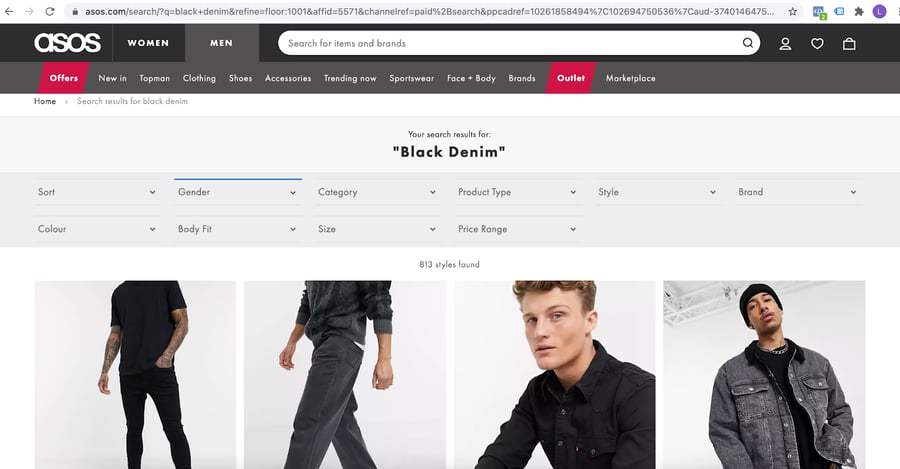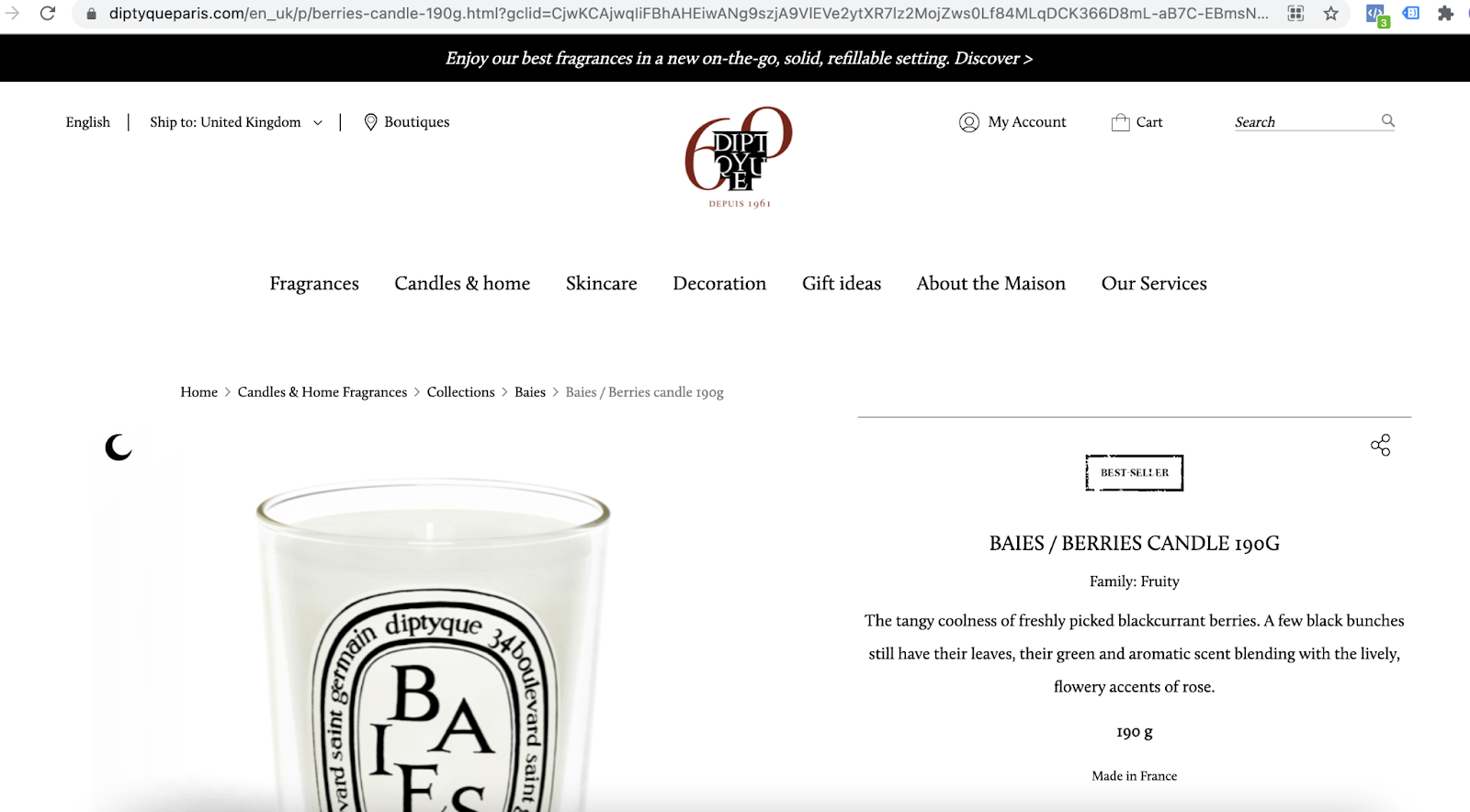Quality Score has been around for a long time. It was released in 2005 and to begin with, OG PPC marketers may remember the Quality Score of keywords being rated with ‘Poor’, ‘OK’ and ‘Great’. As with all things Google Ads, it’s changed a lot since then.
This article looks at 7 ways you can improve your Google Quality Score. First, we cover the basics, looking at:
- What Google’s Quality Score is
- Why Quality Score is so important
- How Quality Score is measured and the factors that affect it
- Finally, we’ll discuss 7 ways in which you can improve your Quality Score
What is Google’s Quality Score?
The Quality Score is a rating that looks at the overall relevance of keywords, ads, the landing page and landing page experience. It is measured using a scale of 1-10, with 1 being the lowest and 10 being the highest.
In practice, Quality Score works by acting as a general guide for whether or not an advertiser's ads are relevant and useful. The higher the Quality Score, the more relevant and useful an ad is perceived to be by Google. Vice versa for a lower quality score.
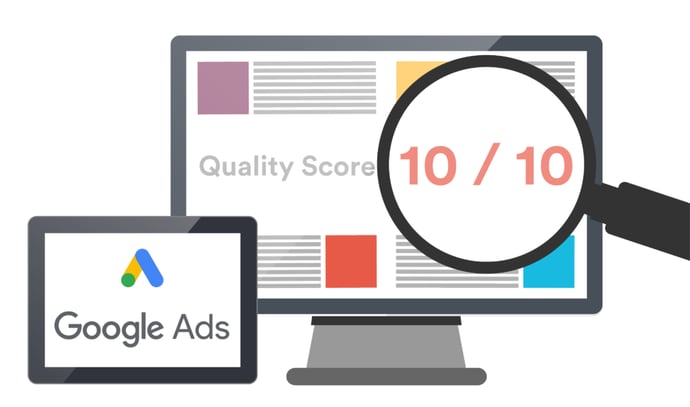
Why is Quality Score Important?
Firstly, it’s important to note that Quality Score should remain separate to key performance metrics. You should not optimize towards Quality Score, but instead use Quality Score to identify areas that require optimization.
This leads on to why Quality Score is so important. There are two main reasons why:
- From Google’s perspective, Quality Score is important because it tells Google how relevant your ad is. If Google doesn’t perceive your ad as being relevant, it may not get served at all.
Google wants to remain the number 1 search engine and can use Quality Score to ensure ads are relevant for searchers. This way, Google can deliver the best possible experience to searchers. - From an advertiser perspective, Quality Score is really important because it ultimately determines the success of your account. Quality Score is used to determine Ad Rank, along with your bid. The advertiser with the highest Ad Rank will have the highest ad position on Google.
The image below shows the formula used to determine Ad Rank, with Quality Score playing a big role. This means that having the highest bid and biggest budget does not translate to having the best ad position and visibility.
Advertisers still need to deliver relevant ads and offer a good overall user experience, along with their bid, in order to be competitive and achieve a number 1 position.
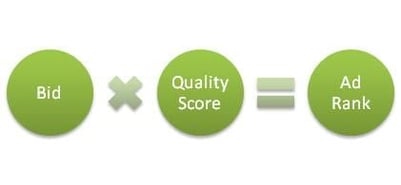
This explains why brand Google Search campaigns almost always have a lower average CPC compared to generic search campaigns. Whilst being able to achieve a high ad rank and position too. Why?
You can’t get more relevant than bidding on your own brand name. Also, competitors will struggle to achieve higher relevance than you, when bidding on your brand terms.
3 Factors that affect Quality Score
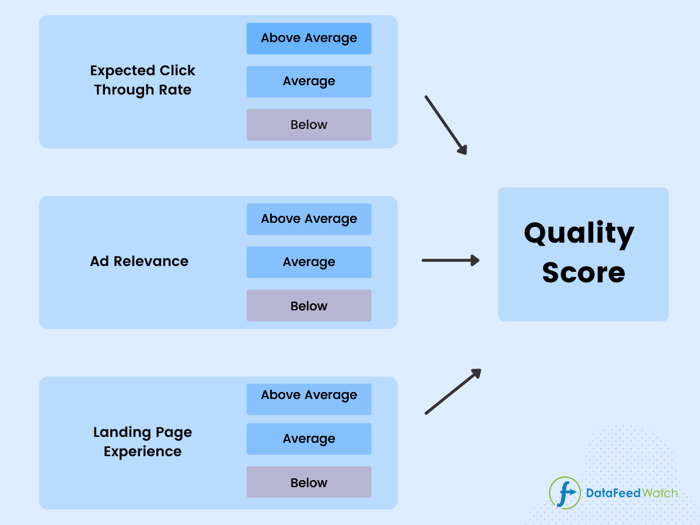
This leads onto the 3 factors that affect Quality Score. The need to be relevant, as we’ve already touched upon, is important. Ad Relevance makes up one of the three key components that determine Quality Score. The other two factors are Expected Click-Through Rate and Landing Page Experience.
Each component is rated with either 'Above average', 'Average' or 'Below average'. This is determined by evaluating these components alongside other advertisers who have bid on the same keyword over the last 90 days. A status of 'Average' or 'Below average' highlights an opportunity to make improvements.
According to Adalysis, Landing Page Experience and CTR are weighted slightly higher than Ad Relevance, when calculating Quality Score.
You can check your rating for each of these components in by adding a column at keyword level:
1. Ad relevance
This Google Ads metric measures how closely your keyword matches the message in your ads. An above average score is an indication that your ads relate closely to keywords within an ad group. A below average score may be because ad copy is too general, or perhaps the keyword is not relevant to your business.
2. Expected Click-Through Rate (CTR)
Google uses expected CTR to estimate the rate in which people searching for your keywords will click on your ad. As with all components of Quality Score, it’s measured with either ‘Above average’, ‘Average’, or ‘Below average’. Expected CTR is calculated by looking at the past-CTR performance of ads. ‘
3. Landing page experience
Landing page experience refers to how relevant and useful your landing page is, once a user has clicked on an ad. Things to consider here are your bounce rate and site speed. If bounce rate is high, and/or your landing page takes a long time to load, then Quality Score will suffer.
7 Ways to increase Quality Score
As we’ve now discovered, there are a number of moving parts to Quality Score. It’s not a case of making a couple of tweaks at an ad group or keyword level, and instantly seeing results.
The following techniques for increasing Quality Score will involve some analysis. Go through each step to determine your current level of success. Work through areas that can be improved and overtime, monitor the impact these changes have on Quality Score.
1. Campaign, ad group and keyword structure
Organise campaigns and ad groups with a granular structure, using as many ad groups as necessary. Within each ad group, only include closely related keywords. This will mean that ads within a given ad group can be better tailored to keywords. A granular set up has other benefits when it comes to optimization, but it’s also really important for Quality Score.
Opting for a less granular structure will immediately compromise ad relevance and CTR, since it would be harder to tailor the ads to a large number of keywords within one ad group.
As an example, an online sweets shop should adopt the following ad group and keyword structure when building campaigns. This ensures ads within each ad group are relevant and closely related to the ad groups keywords:
| Ad group | Keywords |
| Online Sweet Shop | online sweet shop, sweet shop online, online sweet shop delivery |
| Sweets Delivery | sweets delivery, sweets next day delivery, sweets delivery near me |
| Letterbox Sweets | letterbox sweets, letterbox sweets delivery |
| Pick & Mix Sweets | pick and mix sweets delivery, pick and mix sweets online |
| Order Sweets | order sweets online, order sweets delivery |
| Fizzy Sweets | fizzy sweets delivery, fizzy sweets online, order fizzy sweets |
| Sweets Delivery London | london sweets delivery, sweet delivery in London |
Tools that can help
Easiest way to go granular? Use a search automation tool with functionality to generate keywords based on product features. A great example is the feed-driven solution by DataFeedWatch. Here’s how it works:
1. You connect your product feed to Search campaigns builder
2. Then, you choose the data you want to use to create your keywords:
- Keywords by product name truncation:
In most cases advertisers opt for product title-based keywords. The tool will take the full name of your product and truncate it word by word. That way several relevant keywords are created for each product. Here’s an example:
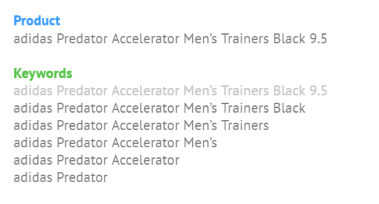 The best part is that you get a mix of specific long-tail keywords (good for conversion), and broader keywords that will drive more traffic to your ads. Oh, and you don’t have to worry about lumping the 2 together.
The best part is that you get a mix of specific long-tail keywords (good for conversion), and broader keywords that will drive more traffic to your ads. Oh, and you don’t have to worry about lumping the 2 together.
A long-tail keyword such as: “adidas Predator Accelerator Men’s Trainers Black” will trigger an ad leading directly to the product page.
A more generic keyword such as “adidas Predator” will be matched with a landing page showcasing all relevant products.
- Keywords by tag combination:
You will also have an option to create keywords by combining any other product information available in your feed.
For example, if you’re selling TVs, you may want to combine brand and model number to reflect the way your (future) customers search for items when close to making a purchase decision.
2. Write relevant and compelling ad copy
Following on from the previous step, write relevant and compelling ad copy. Include the best performing keywords within an ad group in an ad’s headline, description and URL slug. The two main benefits of this are the following:
- The person searching will see their search query in the ad copy, meaning they will be more likely to click on the ad, increasing CTR
- Google will perceive a higher ad relevance, one of the key components that make up Quality Score
It’s important that ad copy doesn’t come across robotic and instead sounds compelling.
Stand out from the crowd with your ad copy and include keywords in a natural way. Using the online sweet shop as an example, within the ‘Sweets Delivery London’ ad group, the following ad copy includes the keyword and sounds natural:
| Headline 1 | Sweets Delivery in London |
| Headline 2 | Free Next Day Delivery |
| Headline 3 | Order Tasty Pick & Mix Sweets |
| Description 1 | Order tasty sweets online and enjoy next day sweets delivery in London. |
| URL | Sweets-Delivery/London |
Creating tailored ad copy for every one of your products is certainly a great way to increase ad relevance. Unfortunately, a very time-consuming one too.
On the bright side, there are tools that can help you reach the level of granularity needed without putting a strain on your time resources. One of them being the Feed-Driven Search Ads tool.
The ad creation builder allows you to combine any product information you choose, or even add static text to the mix. As you see from the screenshot below, the advertiser used product name, brand, and even product price as dynamic tags to build a universal ad pattern.
Side note: Placing FOMO (fear-of-missing-out) and social proof elements on the ad can yield great conversion rates. Learn more on how to apply these tactics here.
3. Ad format and dynamic headlines
In 2024, the sole type of Text Ads available for running was Responsive Search Ads. These ads allow you to include up to 15 headlines and 4 descriptions. The system will display a combination of up to 3 headlines and 2 descriptions, with Google selecting the most appropriate text based on the search query
Other ad considerations that boost CTR are the use of dynamic ad headlines:
- Keyword Insertion is one option, which essentially pulls in a user’s search query as the headline making the ad extremely relevant to the search
- Location Insertion pulls the user’s nearest City / State / Country into the ad copy, making the ad highly relevant for them
- Countdown is another dynamic feature, great when running special offers that have an end date. Countdown can increase urgency and therefore increase CTR
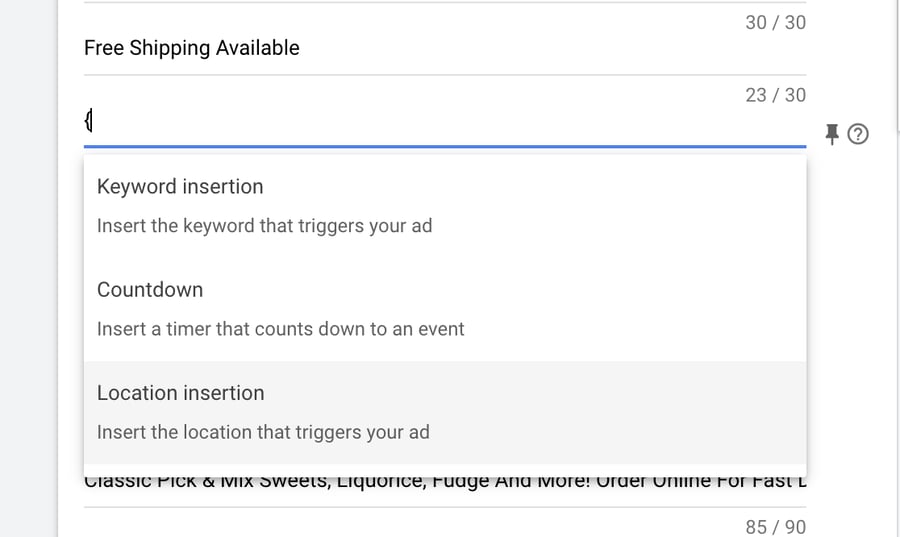 (Screenshot showing dynamic headline options for responsive search ads)
(Screenshot showing dynamic headline options for responsive search ads)
4. Include as many relevant ad extensions possible
Although ad extensions do not directly impact Quality Score, they have been proven to increase CTR.
Ad extensions are a way of expanding your ad. They increase the amount of space your ad uses up in the search engine and give users additional information about your business and offering. Therefore, your CTR and expected click-through rate will benefit from including as many relevant ad extensions as possible.
As a rule of thumb, site links, callouts and structured snippet extensions are relevant to almost all businesses and should always be included. Beyond that, the more the merrier applies to additional ad extensions that are relevant to you. Whether it’s price, promotion, location etc.
Here’s a overview of Google ad extensions:
| Sitelinks | Show links to specific pages on your website |
| Callouts | Show descriptive text, such as 'Free Delivery' |
| Structured snippets | Showcase helpful features or aspects of your business |
| Promotion | Promote a sale or special offer |
| Call | Enable searchers to call your business from an ad |
| Lead form | Generate leads from a lead form in the ad |
| Location | Show your business location |
| App | Include a link to your app |
| Image | Complement your ad with relevant images |
| Affiliate location | Help people find stores that sell your products |
Here’s an example of an ad by Aesop with Callouts, Sitelinks and Location ad extensions:

5. Use negative keywords and review campaigns regularly
When phrase and broad keyword match-types are in play, ensure you are using a robust list of negative keywords. This is a best practice and will automatically exclude search queries that you know are not relevant to your business.
By excluding non-relevant searches from the get go, your ad relevance and CTR will not be negatively impacted. Webmechanix has compiled a list of 1,500+ negative keywords that should be considered, based on your sector.
The process of reviewing search queries in Google Ads should be part of ongoing maintenance work. Stay on top of search queries by reviewing them each week.
Keep excluding non-relevant search queries by adding them as negative keywords as they come in. The below screenshot shows where you can find ‘Search Terms’ in Google Ads, in the Keywords section:
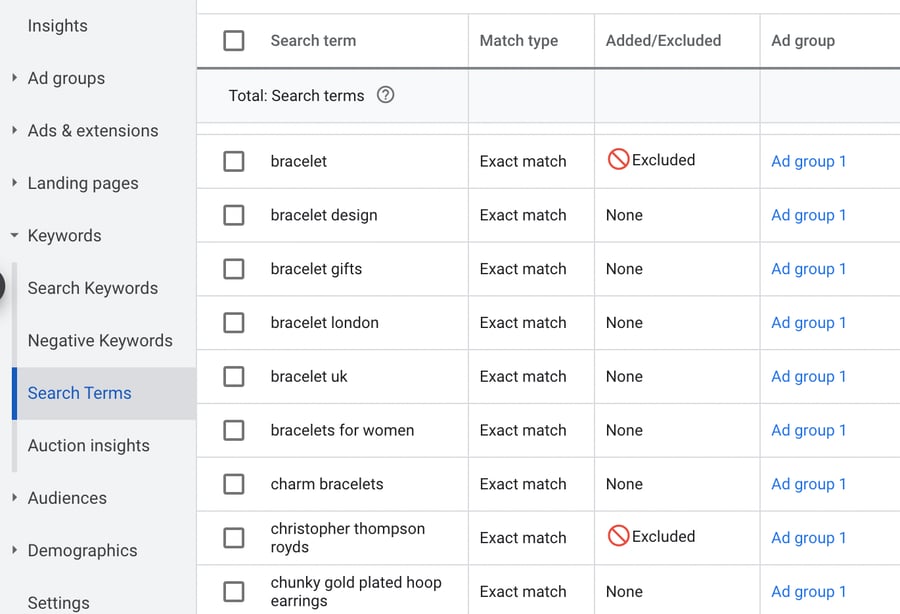
Search queries that deliver a low CTR can also be excluded. Alternatively, if a search query is relevant but has a low CTR, consider creating a new ad group for that query. This will enable you to better tailor ad copy to the search query, which should increase ad relevance and CTR.
6. Work on the landing page
Landing page experience is a key component of determining your Quality Score. The 5 previous steps focus on campaign and ad group structure, ad relevance and generally improving CTR.
However, optimization work to improve Quality Score does not end there and it’s important to consider the following factors on your landing page:
- The messaging is consistent, from keyword to ad, and then ad to landing page. Ensure the keywords are present on the landing page and the landing page is consistent with what is being searched for
- Use the best URL possible for every ad group, in terms of giving the searcher exactly what they are looking for. For example, if someone is searching for pick and mix sweets, send them to a page that feature sweets, rather than the homepage or another type of product
If you’re using Feed-Driven Text Ads by DataFeedWatch - you can automatically use a landing page that features all relevant products. As long as you have a built-in search functionality in your store and the shopper’s query is broad enough to match several of your products - you’re able to generate the perfect group landing page.
Below you can see an example group landing page for the keyword “adidas adipure pants” that matches more than 1 product on the store.
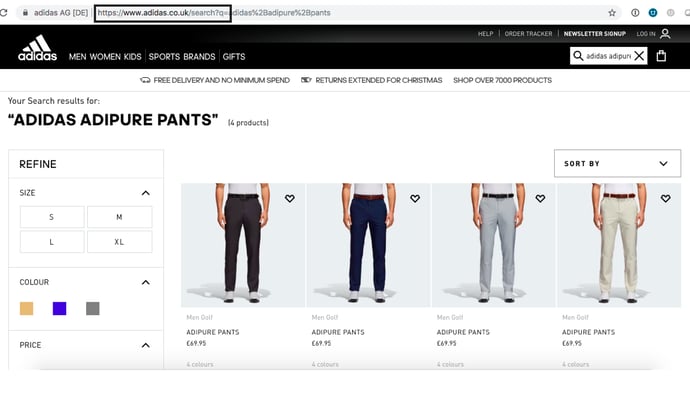
- How is your bounce rate? Google will perceive landing pages with a high bounce rate as having low relevance. Once users land on your website, lower bounce rate by guiding them with a clear and simple user journey. Minimise the number of steps needed in order for a user to convert
- Ensure your website is mobile friendly. When users click on your ad from a mobile device, give them the best user experience possible. Users now expect websites to be easy to navigate on mobile
Landing page examples
Asos.com, Diptyque.com and Etsy.com are all good examples of landing pages from a PPC perspective. The products are well categorized and pages contain relevant, keyword-rich descriptions and text. The sites are mobile friendly too.
Asos.com
| Keyword | Men’s black denim jeans |
| URL | https://www.asos.com/search/?q=black+denim&refine=floor:1001&affid=5571 |
| What they did well |
|
Diptyque.com
|
Keyword |
Diptyque baies candle |
| URL | https://www.diptyqueparis.com/en_uk/p/berries-candle-190g.html |
| What they did well |
|
Etsy.com
| Keyword | Etsy garden |
| URL | https://www.etsy.com/uk/market/garden |
| What they did well |
|
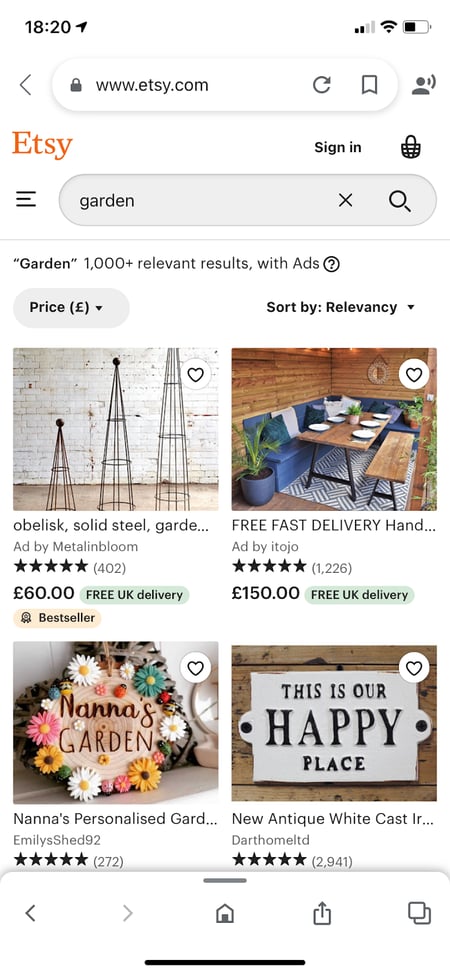
7. Improve site speed
Following on from the last step, site speed is a really important consideration. Sites that are slow to load affect user experience and therefore can negatively impact Quality Score. Sites that are quick to load deliver better experiences, are less disruptive and generally lead to better performance.
As a starting point, use Google’s free site speed tool to analyze your site speed and gain valuable insights. It gives you a score out of 100, along with opportunities and suggestions that will help your page load faster.
Google page speed tool: https://developers.google.com/speed/pagespeed/insights/
Site spend can mean the difference between someone bouncing, or going on to convert. Therefore, it’s a really important consideration for Quality Score, as well as improving performance in general.
Quality Score directly impacts performance
The above techniques for increasing Quality Score will directly impact overall results.
By improving ad relevance and landing page experience, and achieving a higher CTR, you should see an increase in Ad Rank.
This may translate to a lower average CPC and lower costs overall, as well as enabling you to be more competitive.
And remember! No improvement strategy would be complete without a proper way of measuring the results. Here’s a step by step guide on How to Track The Development of Your Quality Score - it will help you understand the impact of the changes you’re making.
